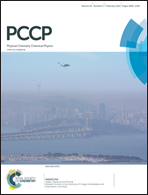Multi-scale modeling of mycosubtilin lipopeptides at the air/water interface: structure and optical second harmonic generation†
Abstract
Monolayers of the lipopeptide mycosubtilin are studied at the air/water interface. Their structure is investigated using molecular dynamics simulations. All-atom models suggest that the lipopeptide is flexible and aggregates at the interface. To achieve simulation times of several microseconds, a coarse-grained (CG) model based on the MARTINI force field was also used. These CG simulations describe the formation of half-micelles at the interface for surface densities up to 1 lipopeptide per nm2. In these aggregates, the tyrosine side chain orientation is found to be constrained: on average, its main axis, as defined along the C–OH bond, aligns along the interface normal and points towards the air side. The origin of the optical second harmonic generation (SHG) from mycosubtilin monolayers at the air/water interface is also investigated. The molecular hyperpolarizability of the lipopeptide is obtained from quantum chemistry calculations. The tyrosine side chain contribution to the hyperpolarizability is found to be dominant. The orientation distribution of tyrosine, associated with a dominant hyperpolarizability component along the C–OH bond of the tyrosine, yields a ratio of the susceptibility elements χ(2)ZZZ/χ(2)ZXX consistent with the experimental measurements recently reported by M. N. Nasir et al. [Phys. Chem. Chem. Phys., 2013, 15, 19919].


 Please wait while we load your content...
Please wait while we load your content...